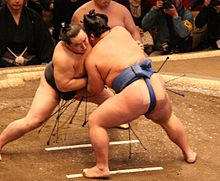Sumotori

A sumo match (tori-kumi) between former yokozuna Asashōryū (left) and then-komusubi Kotoshōgiku in January 2008.
|
|
| Focus | Grappling |
|---|---|
| Hardness | Full contact |
| Country of origin | Japan |
| Olympic sport | No, but recognized by the IOC |
| Official website | www |
Sumo (相撲 sumō?) or sumo wrestling is a competitive full-contact wrestling sport where a rikishi (wrestler) attempts to force another wrestler out of a circular ring (dohyō) or into touching the ground with anything other than the soles of his feet. The characters 相撲 literally mean "striking one another".
The sport originated in Japan, the only country where it is practiced professionally. It is generally considered a gendai budō (a modern Japanese martial art), but this definition is misleading, as the sport has a history spanning many centuries. Many ancient traditions have been preserved in sumo, and even today the sport includes many ritual elements, such as the use of salt purification, from the days when sumo was used in the Shinto religion. Life as a wrestler is highly regimented, with rules regulated by the Japan Sumo Association. Most sumo wrestlers are required to live in communal sumo training stables, known in Japanese as heya, where all aspects of their daily lives—from meals to their manner of dress—are dictated by strict tradition.
In recent years, a number of high-profile controversies and scandals have rocked the sumo world, with an associated effect on its reputation and ticket sales. These have also affected the sport's ability to attract new recruits. Despite this setback, sumo's popularity and general attendance has rebounded due to having multiple yokozuna (or grand champions) for the first time in a number of years and other high-profile wrestlers such as Endō and Ichinojō grabbing the public's attention.
...
Wikipedia
